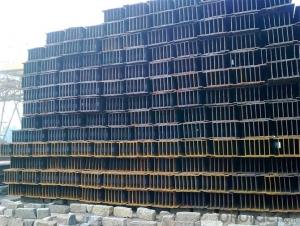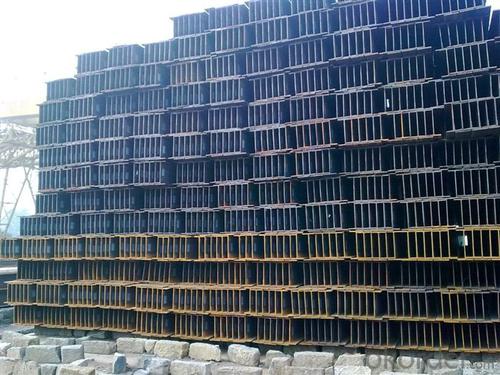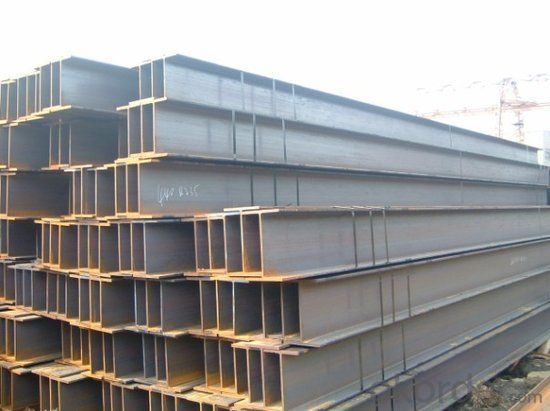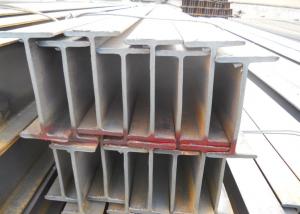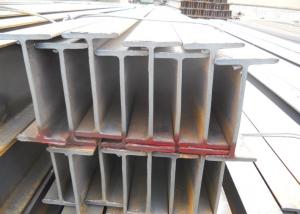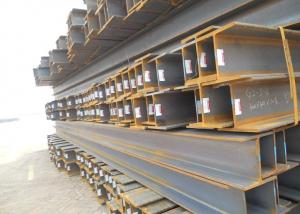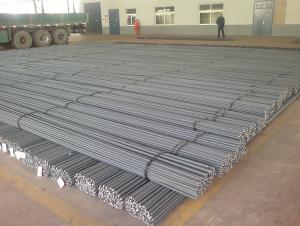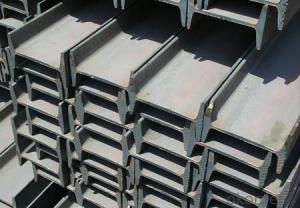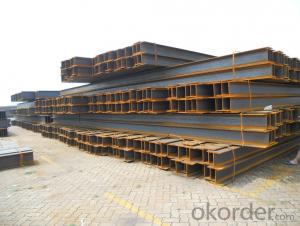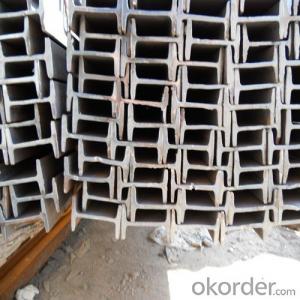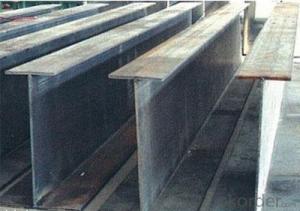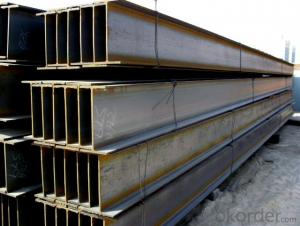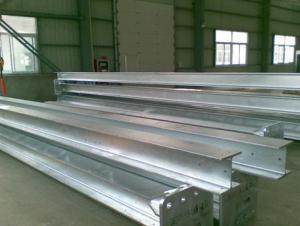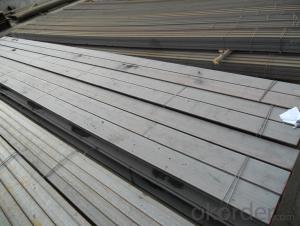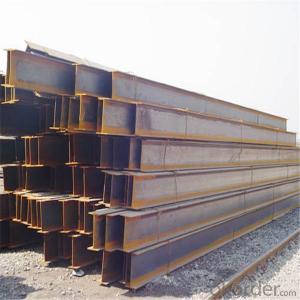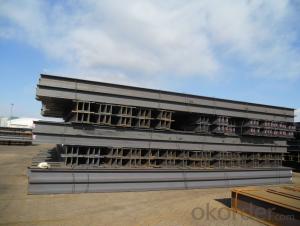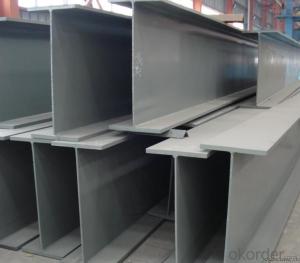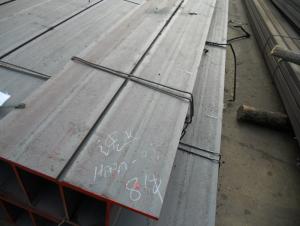Mild Carbon Steel H Beam
- Loading Port:
- China Main Port
- Payment Terms:
- TT or LC
- Min Order Qty:
- -
- Supply Capability:
- -
OKorder Service Pledge
OKorder Financial Service
You Might Also Like
Product Description:
OKorder is offering Mild Carbon Steel H Beam at great prices with worldwide shipping. Our supplier is a world-class manufacturer of steel, with our products utilized the world over. OKorder annually supplies products to African, South American and Asian markets. We provide quotations within 24 hours of receiving an inquiry and guarantee competitive prices.
Product Applications:
Mild Carbon Steel H Beam are ideal for structural applications and are widely used in the plant, high-rise building construction, the bridge, shipment building, lifting and transportation machinery, equipment manufacturing base building, the support, foundation pile manufacturing etc.
Product Advantages:
OKorder's Mild Carbon Steel H Beam are durable, strong, and wide variety of sizes.
Main Product Features:
· Premium quality
· Prompt delivery & seaworthy packing (30 days after receiving deposit)
· Can be recycled and reused
· Mill test certification
· Professional Service
· Competitive pricing
Product Specifications:
Manufacture: Hot rolled
Grade: Q195 – 235
Certificates: ISO, SGS, BV, CIQ
Length: 12m, as per customer request
Packaging: Export packing, nude packing, bundled
SIZE(mm) | DIMENSION(kg/m) |
100*100 | 16.9 |
125*125 | 23.6 |
150*75 | 14 |
150*150 | 31.1 |
148*100 | 20.7 |
198*99 | 17.8 |
200*100 | 20.9 |
248*124 | 25.1 |
250*125 | 29 |
300*150 | 36.7 |
298*149 | 32 |
200*200 | 49.9 |
294*200 | 55.8 |
346*174 | 41.2 |
350*175 | 49.4 |
244*175 | 43.6 |
175*175 | 40.4 |
294*200 | 55.8 |
298*201 | 64.4 |
346*174 | 41.2 |
350*175 | 49.4 |
400*200 | 65.4 |
396*199 | 56.1 |
450*200 | 74.9 |
446*199 | 65.1 |
340*250 | 78.1 |
500*200 | 88.1 |
300*150 | 36.7 |
FAQ:
Q1: Why buy Materials & Equipment from OKorder.com?
A1: All products offered byOKorder.com are carefully selected from China's most reliable manufacturing enterprises. Through its ISO certifications, OKorder.com adheres to the highest standards and a commitment to supply chain safety and customer satisfaction.
Q2: How do we guarantee the quality of our products?
A2: We have established an advanced quality management system which conducts strict quality tests at every step, from raw materials to the final product. At the same time, we provide extensive follow-up service assurances as required.
Q3: How soon can we receive the product after purchase?
A3: Within three days of placing an order, we will arrange production. The normal sizes with the normal grade can be produced within one month. The specific shipping date is dependent upon international and government factors, the delivery to international main port about 45-60days.
Images:
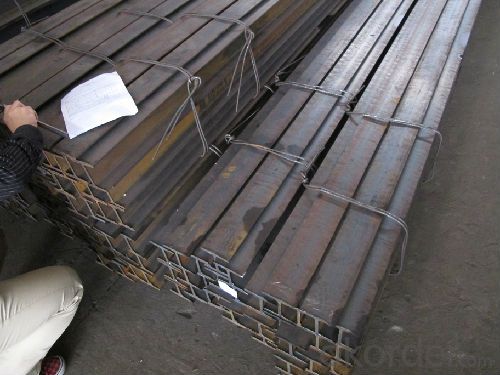
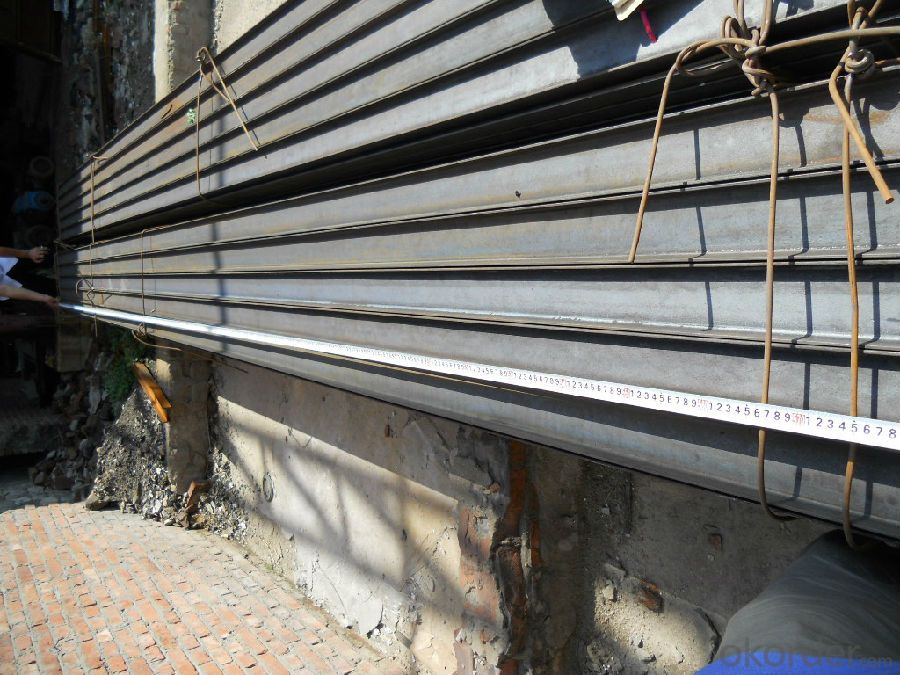
- Q: What are the different sizes and dimensions available for steel H-beams?
- Various construction and engineering applications can be accommodated by a wide range of sizes and dimensions of steel H-beams. The manufacturer and project specifications determine the specific sizes and dimensions of steel H-beams, which can vary. Steel H-beams are typically characterized by their depth, width, and weight per unit length. The depth of the H-beam refers to the height of its web, while the flange width signifies the width. The weight per unit length indicates the beam's weight per unit length, commonly measured in pounds per foot or kilograms per meter. Steel H-beams commonly come in sizes with a depth ranging from 4 inches to 36 inches and a width ranging from 5 inches to 12 inches. However, manufacturers may offer larger or smaller sizes. The weight per unit length of steel H-beams greatly varies based on the beam's size and grade. For instance, a 10-inch by 6-inch steel H-beam may weigh approximately 15 pounds per foot, whereas a 12-inch by 12-inch H-beam can weigh up to 90 pounds per foot. It is important to consider that the availability of specific sizes and dimensions may differ depending on the market and manufacturer. Some manufacturers may provide customized sizes and dimensions to meet specific project requirements. For more precise information on the available sizes and dimensions of steel H-beams, it is advisable to consult a structural engineer or contact steel suppliers.
- Q: What are the different types of corrosion protection coatings for steel H-beams?
- There are several types of corrosion protection coatings available for steel H-beams. Some common options include hot-dip galvanizing, epoxy coatings, zinc-rich paints, and powder coatings. These coatings provide a barrier between the steel surface and corrosive elements, preventing oxidation and rust formation. The choice of coating depends on factors such as the environment, required durability, and cost-effectiveness.
- Q: What are the factors to consider when selecting steel H-beams for a construction project?
- When selecting steel H-beams for a construction project, there are several important factors to consider. 1. Load-bearing capacity: The primary purpose of H-beams is to provide structural support and bear heavy loads. Therefore, it is crucial to determine the anticipated load requirements for the construction project. The load-bearing capacity of H-beams is typically specified by their height, thickness, and the type of steel used. 2. Size and dimensions: H-beams come in various sizes and dimensions, and it is essential to select the appropriate size that can adequately support the structure. The height, width, and thickness of the beam should be carefully chosen based on the design requirements and anticipated loads. 3. Steel grade: The selection of steel grade is crucial as it determines the strength and durability of the H-beams. Different steel grades have varying mechanical properties, such as yield strength and tensile strength. It is important to consult with a structural engineer or steel supplier to identify the suitable steel grade for the project. 4. Cost-effectiveness: While ensuring the structural integrity of the construction project is paramount, it is also crucial to consider the cost-effectiveness of the selected H-beams. Comparing prices from different suppliers and considering factors such as transportation costs and availability can help in making an informed decision. 5. Compatibility with other materials: H-beams are often used in conjunction with other construction materials, such as concrete or wood. It is important to ensure that the selected H-beam is compatible with these materials and can be easily integrated into the overall design and construction process. 6. Quality and certification: When selecting steel H-beams, it is essential to ensure that they meet the required quality standards and are certified by relevant authorities. This helps ensure that the beams have been manufactured using appropriate processes and adhere to industry standards. In conclusion, when selecting steel H-beams for a construction project, factors such as load-bearing capacity, size and dimensions, steel grade, cost-effectiveness, compatibility with other materials, and quality and certification should be carefully considered to ensure the structural integrity and success of the project.
- Q: What are the different finishes available for steel H-beams?
- Steel H-beams offer a range of finishes, each with its own purpose and benefits. Some commonly used finishes are as follows: 1. Mill finish: The raw and untreated surface of the steel beam as it comes from the mill. It is typically used when aesthetics are not a major concern. 2. Hot-dip galvanized: The steel H-beam is immersed in molten zinc, creating a protective coating against corrosion. Ideal for outdoor or exposed environments. 3. Powder coating: A dry powder is electrostatically applied to the surface and then cured under heat, resulting in a durable and attractive finish. Provides excellent resistance to chipping, scratching, and fading, suitable for indoor and outdoor applications. 4. Painted finish: Steel H-beams can be painted in various colors and finishes to protect against corrosion. Commonly used in construction or architectural projects. 5. Epoxy coating: Multiple layers of epoxy coatings offer high chemical resistance, abrasion protection, and corrosion resistance. Often used in industrial and marine environments. When choosing a finish for steel H-beams, it's important to consider project requirements such as environment, exposure level, aesthetics, and budget. Consulting with professionals or steel suppliers can help ensure the chosen finish meets your needs for protection and durability.
- Q: Can steel H-beams be used in hotel or hospitality industry construction?
- The construction of hotels and hospitality establishments can incorporate steel H-beams, which are widely utilized in the construction industry due to their exceptional strength, durability, and versatility. These beams are commonly employed as structural support in building frameworks, including hotels and hospitality establishments. Steel H-beams possess excellent load-bearing capabilities, enabling them to withstand heavy loads and contribute stability to the structure. Consequently, they are suitable for erecting multi-story buildings like hotels, where the weight of the edifice must be evenly distributed. Furthermore, steel H-beams are easily fabricated and assembled, making them a favored choice in the construction sector. They can be tailored to specific dimensions, lengths, and shapes to meet the unique requirements of each project. Moreover, steel H-beams exhibit great resistance to fire, an essential feature for ensuring the safety of occupants in hotel and hospitality buildings. Additionally, they boast a long lifespan and require minimal maintenance, resulting in reduced construction and operational costs in the long term. In summary, steel H-beams serve as a dependable and efficient option for constructing hotels and hospitality establishments, delivering structural strength, durability, and safety.
- Q: Can steel H-beams be used in theater or auditorium construction?
- Yes, steel H-beams can be used in theater or auditorium construction. They are commonly utilized as structural support elements due to their strength, durability, and ability to bear heavy loads. Steel H-beams provide excellent structural integrity and can contribute to the overall safety and longevity of the theater or auditorium.
- Q: What are the common challenges faced during the installation of steel H-beams?
- Several challenges may arise during the installation of steel H-beams. These challenges encompass the following: 1. Weight and size: The large and heavy nature of steel H-beams makes their handling and maneuvering during installation difficult. The transportation and positioning of these beams can prove challenging due to their weight and size. 2. Alignment: Ensuring proper alignment of H-beams is crucial for structural integrity. Achieving perfect vertical and horizontal alignment, particularly when dealing with multiple beams or long spans, can be challenging. 3. Connection methods: Securely connecting H-beams to other structural elements, such as columns or foundations, presents a challenge. The selection of an appropriate connection method and ensuring its proper execution require specialized knowledge and expertise. 4. Crane and equipment limitations: The installation of steel H-beams often necessitates the use of cranes and other heavy equipment. However, these machines have limitations in terms of lifting capacity, reach, and access to the construction site. Overcoming these limitations, especially in tight or congested areas, can be challenging. 5. Safety considerations: The installation of steel H-beams involves working at heights and handling heavy materials, thus raising safety concerns for the workers involved. Mitigating these risks necessitates the implementation of proper safety measures, such as fall protection, correct lifting techniques, and comprehensive training. 6. Site conditions: The condition of the construction site can also present challenges during the installation of steel H-beams. Uneven or unstable ground, restricted access, and adverse weather conditions can all affect the installation process, requiring additional planning and precautions. To overcome these challenges, it is crucial to have a well-coordinated plan, skilled personnel, and appropriate equipment. Engaging experienced professionals and facilitating effective communication among all parties involved can help address these challenges and ensure a successful installation of steel H-beams.
- Q: How do you calculate the deflection limits for steel H-beams?
- To determine the deflection limits for steel H-beams, several factors must be considered. Typically, the deflection limits are established by relevant building codes or industry standards. The steps below outline the general process of calculating these limits: 1. Find the applicable building code or industry standard: Building codes or industry standards, such as the American Institute of Steel Construction (AISC) code, usually specify the deflection limits. These codes provide guidelines based on the intended use of the structure. 2. Gather information about the H-beam: Collect the necessary details about the H-beam, including dimensions, material properties, and support conditions. This information can be obtained from the manufacturer or relevant design resources. 3. Calculate the moment of inertia: The moment of inertia measures the beam's resistance to bending. It is determined by the beam's dimensions and geometry. The moment of inertia plays a critical role in determining the deflection of the beam. 4. Identify the applied load: Determine the load or loads that will act on the H-beam. This may include dead loads, live loads, wind loads, or other specified loads according to design requirements. 5. Use the appropriate deflection formula: The choice of deflection formula depends on the type of loading and support conditions. Common formulas include the Euler-Bernoulli beam equation, which assumes linear elastic behavior, and the Timoshenko beam equation, which considers shear deformations. 6. Calculate the maximum allowable deflection: Utilize the deflection formula to input relevant parameters such as applied load, beam properties, and support conditions. Calculate the deflection at various points along the beam and compare these values to the deflection limits specified in the building code or industry standard. 7. Ensure compliance with deflection limits: If the calculated deflection exceeds the specified limits, adjustments must be made to the beam's dimensions, material, or support conditions. This may involve increasing the beam size, using a stronger material, or adding additional support. It is important to note that calculating deflection limits for steel H-beams can be a complex process that may require the expertise of a structural engineer or designer. Adhering to the applicable building codes and industry standards is crucial to ensure project safety and structural integrity.
- Q: Model H is 580*280*12*14. How much is the theoretical weight of the steel?It's better to list the complete formula, thank you!
- Quality = volume * density, the density of steel, 7.85g/cm3,0.785 is a fast algorithm, the essence should be: unit weight =144.64cm2*100cm*7.85g/cm3=113542.4g=113.54kg. 0.785=100*7.85/1000.
- Q: How are steel H-beams different from other structural steel shapes?
- Steel H-beams are different from other structural steel shapes primarily because of their unique cross-sectional shape. The H-beam shape, resembling the letter "H", provides superior strength and load-bearing capacity compared to other shapes like I-beams or channels. This design allows H-beams to withstand heavier loads and distribute weight more efficiently, making them ideal for construction projects requiring high strength and stability.
Send your message to us
Mild Carbon Steel H Beam
- Loading Port:
- China Main Port
- Payment Terms:
- TT or LC
- Min Order Qty:
- -
- Supply Capability:
- -
OKorder Service Pledge
OKorder Financial Service
Similar products
Hot products
Hot Searches
Related keywords
